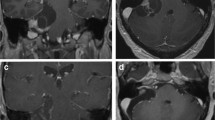Summary
Management of large vestibular schwannoma (VS) remains a difficult problem for which the extent of tumor resection and the role of radiosurgery continue to be the subject of debate. To develop an optimal therapeutic strategy for large VS, various treatment options within the avenues of microsurgery and radiosurgery were evaluated and compared. The authors carefully reviewed the clinical data of 50 surgical cases of large VS, defined as tumors with an average diameter over 3 cm in magnetic resonance imaging (MRI). All patients underwent microsurgery as the primary treatment. Gross total removal (GTR) was achieved in nine patients (18%), near total removal (NTR) in 8 (16%), radical subtotal removal (R-STR) in 31 (62%), and subtotal removal (STR) in 2 (4%). Among the 33 patients with R-STR and STR, eight had undergone adjuvant radiosurgery for the residual mass. Average tumor volume and diameter were 26.8 cm3 (13.5–55.1) and 36.4 mm (30.0–47.2), respectively. The mean follow-up duration was 113 months (58–167). The tumor control rate and facial nerve function according to the extent of removal were analyzed. The overall tumor control rate was 82%. Perfect tumor control was achieved after NTR and R-STR with adjuvant radiosurgery. However, 11% (1 of 9) of GTR patients and 32% (8 of 25) of R-STR-only and STR patients showed recurrence or regrowth. Overall favorable outcome of facial nerve function (H-B grade 1 or 2) was achieved in 78% of the patients. The facial nerve preservation rate was inversely proportional to the extent of tumor removal. NTR or R-STR with adjuvant radiosurgery might be acceptable therapeutic options for large VS in terms of achieving good tumor control and functional preservation of facial nerve.
Similar content being viewed by others
References
Cushing H, Tumors of the Nervus Acusticus and the Syndrome of the Cerebellopontine Angle. WB Saunders, Philadelphia, 1917
Elsmore AJ, Mendoza ND, The operative learning curve for vestibular schwannoma excision via the retrosigmoid approach Br J Neurosurg 16:448–455, 2002
Samii M, Matthies C, Management of 1000 vestibular schwannomas (acoustic neuromas): surgical management and results with an emphasis on complications and how to avoid them Neurosurgery 40:11–21, 1997
Buchman CA, Chen DA, Flannagan P, Wilberger JE, Maroon JC, The learning curve for acoustic tumor surgery Laryngoscope 106:1406–1411, 1996
Moffat DA, Hardy DG, Grey PL, Baguley DM, The operative learning curve and its effect on facial nerve outcome in vestibular schwannoma surgery Am J Otol 17:643–647, 1996
Satar B, Yetiser S, Ozkaptan Y, Impact of tumor size on hearing outcome and facial function with the middle fossa approach for acoustic neuroma: a meta-analytic study Acta Otolaryngol 123:499–505, 2003
Lanman TH, Brackmann DE, Hitselberger WE, Subin B, Report of 190 consecutive cases of large acoustic tumors (vestibular schwannoma) removed via the translabyrinthine approach J Neurosurg 90:617–623, 1999
Ebersold MJ, Harner SG, Beatty CW, Harper CM Jr, Quast LM, Current results of the retrosigmoid approach to acoustic neurinoma J Neurosurg 76:901–909, 1992
Mangham CA, Complications of translabyrinthine vs. suboccipital approach for acoustic tumor surgery Otolaryngol Head Neck Surg 99:396–400, 1988
Nadol JB Jr, Levine R, Ojemann RG, Martuza RL, Montgomery WW, de Sandoval PK, Preservation of hearing in surgical removal of acoustic neuromas of the internal auditory canal and cerebellar pontine angle Laryngoscope 97:1287–1294, 1987
Samii M, Matthies C, Management of 1000 vestibular schwannomas (acoustic neuromas): the facial nerve–preservation and restitution of function Neurosurgery 40:684–694, 1997
Kameyama S, Tanaka R, Kawaguchi T, Honda Y, Yamazaki H, Hasegawa Long-term follow-up of the residual intracanalicular tumours after subtotal removal of acoustic neurinomas. Acta Neurochir (Wien) 138:206–209, 1996
Lownie SP, Drake CG, Radical intracapsular removal of acoustic neurinomas. Long-term follow-up: review of 11 patients J Neurosurg 74:422–425, 1991
Bloch DC, Oghalai JS, Jackler RK, Osofsky M, Pitts LH, The fate of the tumor remnant after less-than-complete acoustic neuroma resection Otolaryngol Head Neck Surg 130:104–112, 2004
Sakaki S, Nakagawa K, Hatakeyama T, Murakami Y, Ohue S, Matsuoka K, Recurrence after incompletely resected acoustic neurinomas Med J Osaka Univ 40:59–66, 1991
Kondziolka D, Nathoo N, Flickinger JC, Niranjan A, Maitz AH, Lunsford LD, Long-term results after radiosurgery for benign intracranial tumors Neurosurgery 53:815–821, 2003
Prasad D, Steiner M, Steiner L, Gamma surgery for vestibular schwannoma J Neurosurg 92:745–759, 2000
Unger F, Walch C, Papaefthymiou G, Feichtinger K, Trummer M, Pendl G, Radiosurgery of residual and recurrent vestibular schwannomas Acta Neurochir (Wien) 144:671–676, 2002
Iwai Y, Yamanaka K, Ishiguro T, Surgery combined with radiosurgery of large acoustic neuromas Surg Neurol 59:283–289, 2003
Acknowledgements
This work was partially supported by grants from the Clinical Research Institute, Seoul National University Hospital and The Korea Brain and Spinal Cord Research Foundation.
Author information
Authors and Affiliations
Corresponding author
Additional information
Address for offprints: Hee-Won Jung, M. D., Ph.D. Professor, Department of Neurosurgery, Seoul National University, College of Medicine, 28 Yongon-dong, Chongno-gu, Seoul 110-744, Korea; Tel.: +822-2702-2355; Fax: 822-744-2339; E-mail : hwnjung@snu.ac.kr
Rights and permissions
About this article
Cite this article
Park, CK., Jung, HW., Kim, J.E. et al. Therapeutic strategy for large vestibular schwannomas. J Neurooncol 77, 167–171 (2006). https://doi.org/10.1007/s11060-005-9015-y
Published:
Issue Date:
DOI: https://doi.org/10.1007/s11060-005-9015-y




